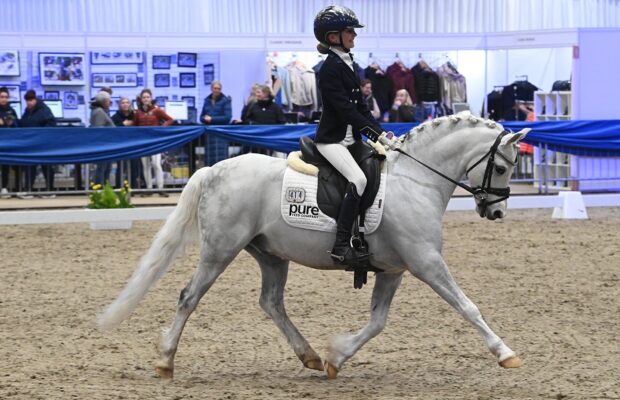Sarah Millis (pictured), an international dressage rider, explains how you can improve the quality and rhythm of the trot by training with half-10m circles and shoulder-in
Aim
This exercise is a great way to teach shoulder-in to young horses, but it can help improve and maintain engagement and suppleness at all ages and levels.
With young horses, when teaching shoulder-in, don’t ask for the movement along the entire long side. Instead, use half-circles to encourage the horse to turn and stay supple.
I don’t ask the horse for too much flexion in the shoulder-in initially — I just teach them how to take the correct positioning and learn to come on to three tracks. Otherwise, they learn to bend the neck too much and fall out through the shoulders. This results in them bending just the neck, rather than allowing the inside hindleg to come under to help create bend through the whole body for a true shoulder-in.
Exercise
1. Trot around the short side of the arena on the left rein then, from F to D, ride a half-10m circle left followed by a half-10m circle right to K. Make sure your horse is carrying himself, straight on the centre line and beginning to flex through his ribcage around your inside leg before turning, so he doesn’t fall on to the inside shoulder.
2. At K, go straight into shoulder-in right until the next marker (V in a 20x60m arena or E in a 20x40m) and repeat, so it’s a continuing exercise you can ride from one end of the arena to the other. When starting to position the shoulder-in, think of beginning another circle so you guide the shoulders around, then ask your horse to yield from your inside leg to a steady outside rein. Your outside leg needs to support his outside hindleg so he doesn’t swing the quarters out.
3. During both movements, focus on the rhythm as it is important that the purity of the horse’s gait is not lost, otherwise he’ll become uneven and lose balance. Ride the exercise from one end of the arena to the other so that you are performing the shoulder-in on both reins.
Tips and pitfalls
- It’s important to keep focused on maintaining a good, active rhythm in the trot. Always refresh your horse’s forward-thinking mind and active hindleg by riding some lengthened strides or medium trot on the long side or diagonal before repeating, or in between if the horse loses impulsion.
- If you don’t have the use of a mirror, it’s important to have someone on the ground videoing from behind and in front so that you can see if you’re staying central over the horse’s back and not slipping to the outside.
- If your horse tends to run on down the long side, try asking for some trot-walk-trot transitions. This will encourage him to wait, instead of you hanging on to the front end and riding him from front to back, when he should be working through from behind with an engaged hindleg.
For all the latest equestrian news and reports, don’t miss Horse & Hound magazine, out every Thursday




